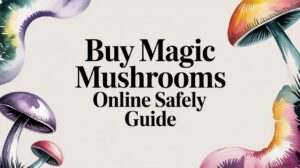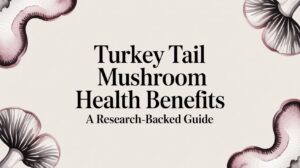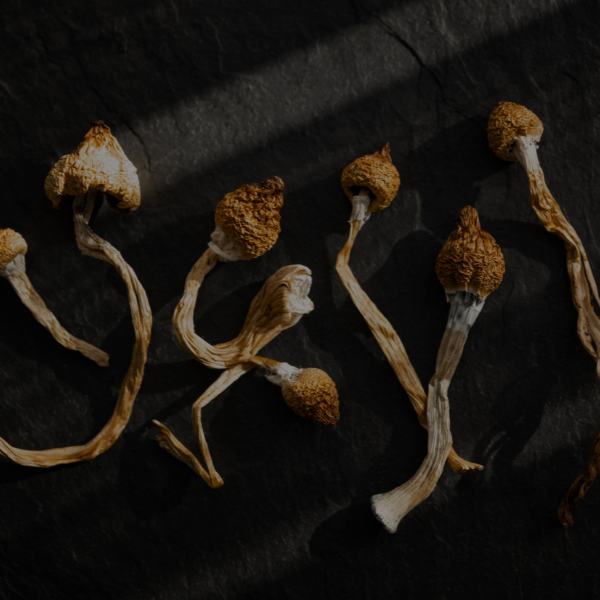So, you’re curious about growing your own magic mushrooms but the whole process seems a bit… scientific? Like you need a lab coat and a microscope just to get started? That’s where a magic mushroom growing kit comes in.
Think of it as your all-in-one “mycology lab in a box.” These kits are built for beginners, taking all the complicated, sterile lab work out of the equation so you can jump right into the fascinating part—watching them grow.
Unpacking the Magic Mushroom Growing Kit
Imagine trying to bake a perfect sourdough loaf from scratch on your first try. You’d have to capture wild yeast from the air, find the right kind of flour, and nail the hydration levels. It’s a lot of work with plenty of room for error. A mushroom grow kit is the fungal equivalent of a sourdough starter kit; it hands you the most difficult parts on a silver platter.
Instead of you having to sterilize grains and mix substrates in a pressure cooker, these kits arrive with everything ready to go. They’re designed to give your mushrooms a clean, contaminant-free head start, which is often the trickiest part of the whole process.
The Core Components of Your Kit
At its heart, every kit is a self-contained little ecosystem waiting to spring to life. Inside, you’ll find two critical elements that make the magic happen: the substrate and the culture.
The table below breaks down the essential parts you’ll typically find inside a standard kit and what each one does. It’s a quick-glance guide to understand the anatomy of your new growing project.
Key Components Inside a Typical Mushroom Grow Kit
| Component | Purpose |
|---|---|
| Sterilized Substrate | This is the mushroom’s food and home. It’s usually a mix of nutrient-rich stuff like grains, coco coir, or vermiculite that’s been professionally sterilized to kill off any nasty bacteria or molds that could ruin your grow. |
| Mushroom Spores or Mycelium | This is the “seed” of your mushroom. Kits will either come with a syringe full of spores for you to inject, or they’ll arrive with the substrate already inoculated with live mycelium (the white, root-like network of the fungus). |
By bundling a pre-sterilized and often pre-inoculated environment, a grow kit massively boosts your odds of seeing a successful harvest on your very first try. It’s a game-changer.
All the tricky microbiology is handled for you. Your job is to focus on the basics: giving it a little light, maintaining humidity, and watching the magic unfold.
This rise in home cultivation is part of a much bigger picture. The global market for psychedelic mushrooms is booming, projected to jump from an estimated $1.5 billion in 2024 to over $3.3 billion by 2031. This explosive growth is fueled by a wave of new research and a growing acceptance of psilocybin’s potential.
Ultimately, a kit is more than just a box of supplies; it’s your ticket into the incredible world of mycology. If you want to dive deeper into the science and effects before you start, our guide on what shrooms are is a fantastic place to begin. Whether you’re growing psilocybin varieties or just some tasty gourmet mushrooms, a kit is the most reliable way to get from spore to harvest.
How Your Mushroom Grow Kit Comes to Life
A magic mushroom growing kit is a brilliant bit of mycology, simplifying a pretty complex biological process. It essentially turns you from a passive observer into a caretaker. Think of it less like you’re actively farming and more like you’re creating the perfect little five-star resort for your fungi to do their thing. The kit has all the hard science figured out; your job is just to provide the right ambiance.
The whole journey kicks off with a stage called colonization. This is the quiet, unseen first act where the mycelium—that white, thread-like network of fungal roots—starts to wake up. It diligently spreads throughout the nutrient-rich block (the substrate) inside your kit, almost like the roots of a plant exploring new soil. This part of the process is all about patience, as the mycelium is busy gathering all the energy it needs for the main event.
From Mycelial Network to Fruiting Bodies
After about one to three weeks of quiet colonization, you’ll start to see the magic happen. The next stage is called fruiting, which is when the mycelium, having completely taken over its food source, starts to produce the actual mushrooms. The first tiny formations are called “pins,” and they’re the first real sign that your patience is about to pay off in a big way.
Your role here is simple but absolutely crucial:
- Keep It Humid: A light misting inside the grow bag each day creates the damp, rainforest-like environment that mushrooms adore.
- Give It Some Light: Find a spot for the kit where it gets natural, indirect light. Never put it in direct sunlight, which is way too harsh and can dry it out.
- Let It Breathe: Opening the bag for a moment allows for fresh air exchange, which is the signal mushrooms need to know it’s time to grow.
The entire process is a lesson in patience. Your kit is designed to succeed with just a little help. Often, the key to a great harvest is resisting the temptation to fuss over it too much.
This simple diagram shows you exactly how things progress, from the moment you get your kit to the final harvest.

As the diagram lays out, it’s a straightforward flow from setup to harvest, with that all-important mycelial growth happening in between.
The Final Harvest
Once those first pins pop up, the mushrooms mature surprisingly fast—often reaching their full size within just a week. You’ll want to harvest them right before the veil underneath the mushroom cap breaks away. This timing ensures they’re at peak potency and also preps the mycelial block for a potential second or even third “flush,” or crop, of mushrooms.
The beauty of a magic mushroom growing kit is that you don’t need a degree in mycology to succeed—you just need to follow a few simple instructions. The kit empowers you to watch a fascinating natural cycle unfold up close, transforming a simple box into a tiny, thriving ecosystem right in your home. It’s an incredibly accessible and rewarding way to get started.
Navigating the Legal and Safety Landscape
Before you jump into the world of home cultivation, it’s absolutely critical to understand the rules of the road. The laws around magic mushroom growing kits are a tangled web, and they change dramatically depending on where you call home. This isn’t a simple yes-or-no question, and getting it wrong can have some pretty serious consequences.
The heart of the legal issue comes down to a fascinating little piece of biology. Mushroom spores, which are basically the microscopic “seeds” of the fungus, typically don’t contain any psilocybin. Because of this loophole, buying and owning spore syringes is legal in most—but not all—parts of the United States.
Here’s the catch, though. The second those spores germinate and start to grow into mycelium, they begin producing psilocybin. At that very moment, the act of growing them can be legally defined as manufacturing a controlled substance, which is a major no-go in most places. This creates a confusing gray area where the raw materials might be perfectly legal to buy, but using them for their intended purpose is not.
Know Your Local Laws
This legal landscape is always shifting. Some cities and states are making moves toward decriminalization or even legalization for therapeutic use. This makes doing your own homework non-negotiable. What’s totally fine in one city could be a felony just a few miles down the highway.
Your first and most important job before buying a magic mushroom growing kit is to dig in and understand the specific laws in your state, county, and city. Pleading ignorance won’t hold up if you get caught on the wrong side of the law.
For a clearer picture of the current regulations, you can explore our detailed breakdown on the legality of magic mushrooms, which offers a state-by-state look at the situation. But always, always double-check the most current local statutes as your final source of truth.
Cultivation Safety and Harm Reduction
Looking beyond the legal stuff, safety has to be your top priority. When you grow mushrooms, you’re basically managing a tiny ecosystem. Unwanted guests like bacteria and mold can crash the party pretty easily. Contamination is the number one enemy of every single home grower.
To make sure you end up with a safe and successful harvest, you need to nail these fundamentals:
- Sterility is Key: Always, always wash your hands thoroughly. Work in a clean, draft-free spot. It’s a good idea to wear gloves and a mask when handling the kit to avoid breathing or touching contaminants onto your project.
- Identify Contamination: Learn what trouble looks like so you can spot it early. Any green, black, or orange patches are tell-tale signs of mold. This means the kit is probably a lost cause and needs to be thrown out safely.
- Practice Responsible Use: If you happen to be in a place where consumption is legally permitted, harm reduction is vital. Understand proper dosing, the incredible importance of set and setting, and never take mushrooms if you’re in a bad headspace or on medications that could conflict.
By approaching your cultivation journey with a clear head about both the legal risks and the safety steps, you can make smart, responsible decisions from start to finish.
Choosing A Quality Mushroom Growing Kit
Not all mushroom growing kits are built the same. With the market exploding, figuring out which kits are legit and which are duds can feel like a chore. The best way to think about it is like buying fresh produce—you’re looking for something that looks healthy, comes from a good source, and is free of anything that could spoil the batch.
The absolute heart of any successful grow is the substrate. This is the nutrient-packed block where all the magic happens and your mycelium thrives. A top-notch kit will always use a professionally sterilized and perfectly hydrated substrate. Honestly, this is the single biggest factor in keeping contamination at bay. The best vendors are totally open about how they sterilize their materials and often lean on premium, organic ingredients.
This kind of attention to detail is what separates the pros from the amateurs. The global market for these kits is expected to blow past $1.5 billion by 2033, which just shows how many people are getting into home cultivation. More choice is great for us, but it also means we need to be a little more careful about who we buy from.
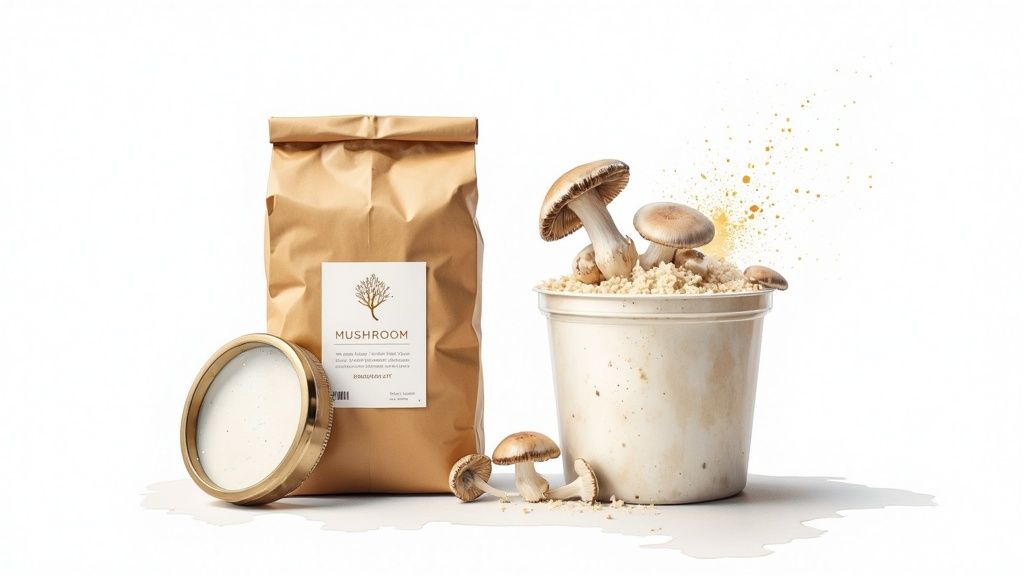
Evaluating Vendors And Kit Types
When you’re checking out a supplier, look for the tell-tale signs of a professional and trustworthy operation. A solid vendor really cares about your success and your privacy, and you can see it in how they do business.
Here are a few key things to keep an eye on:
- Customer Reviews: There’s nothing more valuable than honest, detailed feedback from other growers. Look for consistent comments about success rates, how helpful their customer service is, and the overall quality.
- Discreet Shipping: Privacy is a big deal. A professional company will always ship your kit in plain, unbranded packaging to keep things confidential. No exceptions.
- Clear Instructions: A great kit comes with a guide that’s easy to follow. If the instructions are vague, confusing, or missing altogether, that’s a major red flag.
You can usually tell how committed a vendor is to quality by looking at the resources they provide. Companies that take the time to teach their customers about the process, like explaining our standards for product purity, are generally the ones that offer a much better product and support experience.
Once you’ve found a good vendor, you’ll need to pick the right kind of kit. To help you decide, let’s look at the most common options first-time buyers run into.
Comparing Mushroom Grow Kit Types
Mushroom grow kits generally fall into a few main categories, each with its own set of pros and cons. Choosing the right one really boils down to how much work you want to put in, the space you have available, and what you’re hoping to achieve with your first grow.
This table breaks down the two most popular styles to help you see which one fits your needs.
| Kit Type | Best For | Pros | Cons |
|---|---|---|---|
| All-in-One Grow Bag | Total beginners, small spaces, and anyone wanting a low-maintenance experience. | Extremely simple, self-contained, and has a very low risk of contamination. | Yields are typically smaller than other methods. |
| Monotub Kit | Growers who want a larger harvest and are okay with a more hands-on process. | Can produce significantly larger yields, offers more control over the growing environment. | Higher risk of contamination if not handled carefully, requires more steps and attention. |
Ultimately, the choice between an all-in-one bag and a monotub kit depends on your personal goals. Both are fantastic ways to get started in the world of mycology.
All In One Bags vs Tub Kits
All-in-one grow bags are hands-down the easiest way to get started. The entire process—from the mycelium colonizing the grain to the mushrooms actually fruiting—all happens inside one sealed bag. This setup drastically cuts down the risk of contamination because you never have to move the substrate to a different container. It’s the perfect choice for anyone with limited space or who just wants a simple, set-it-and-forget-it introduction to growing.
Monotub kits, on the other hand, are for those who are aiming for a much bigger harvest and enjoy being more involved in the process. With these kits, you typically let a grain bag get fully colonized first, then transfer it into a large tub filled with more substrate. While this method demands a much stricter focus on keeping everything sterile, it almost always results in a way bigger harvest. It’s a favorite for growers who have a harvest or two under their belt and are ready to scale up.
What to Expect When Ordering Your Kit
So, you’ve decided to buy a magic mushroom growing kit. That’s the first step. Knowing what happens between clicking “buy” and the package landing on your doorstep is the next. Thankfully, ordering from a reputable company is a surprisingly simple and secure process.
Once you find a kit you like and add it to your cart, you’ll go through a pretty standard checkout. Most sellers will require age verification to make sure customers are 21 or older. Think of this as a good sign—it shows you’re dealing with a responsible operator who plays by the rules. It’s a quick check that protects both you and them.
Discreet Shipping and Delivery
Let’s be honest, privacy is a big deal for most first-time buyers. Professional suppliers get this, and that’s why discreet shipping is something they take very seriously. Your kit will show up in a plain, boring box or mailer with zero logos or text that even hints at what’s inside. This keeps your purchase completely confidential.
The packaging is intentionally bland. It’s designed to look like any other package you might get, giving you total peace of mind from the moment it leaves the warehouse until it’s in your hands.
Delivery times can vary, but most sellers provide a tracking number so you can follow your package’s journey. Once it arrives, your first job is to play detective. Before you do anything else, give the kit a thorough inspection for any damage from shipping or, more importantly, contamination. Keep an eye out for any weird colors, especially green or black mold.
Inspecting Your Kit on Arrival
A quality kit should arrive looking clean, sterile, and ready to go. Good vendors stand behind their products, so if you spot any issues right out of the box, get in touch with their customer support immediately. This initial check is a critical first step and sets you up for a successful grow.
This entire process is fueled by a huge global interest in all things fungi. Between 2012 and 2022, worldwide mushroom and truffle production jumped by nearly 52%, climbing from 31.78 to 48.34 million metric tons. This boom in demand helps ensure there’s a steady, reliable market for top-notch growing supplies. You can discover more insights about this global trend on market.us.
Answering Your First-Time Grower Questions
Every new grower has questions. That’s a given. Diving into a hobby like this is exciting, but it’s completely normal to have some practical concerns floating around. We’ve put together this quick guide to tackle the most common questions we hear, giving you clear, straightforward answers to help you get started on the right foot.
One of the first things people always ask is, “How long does this actually take?” From the moment you unbox your kit to your very first harvest, you’re looking at a timeline of about four to six weeks. This covers everything from the initial colonization, where the mycelium takes over, to the final fruiting stage when your mushrooms pop up.
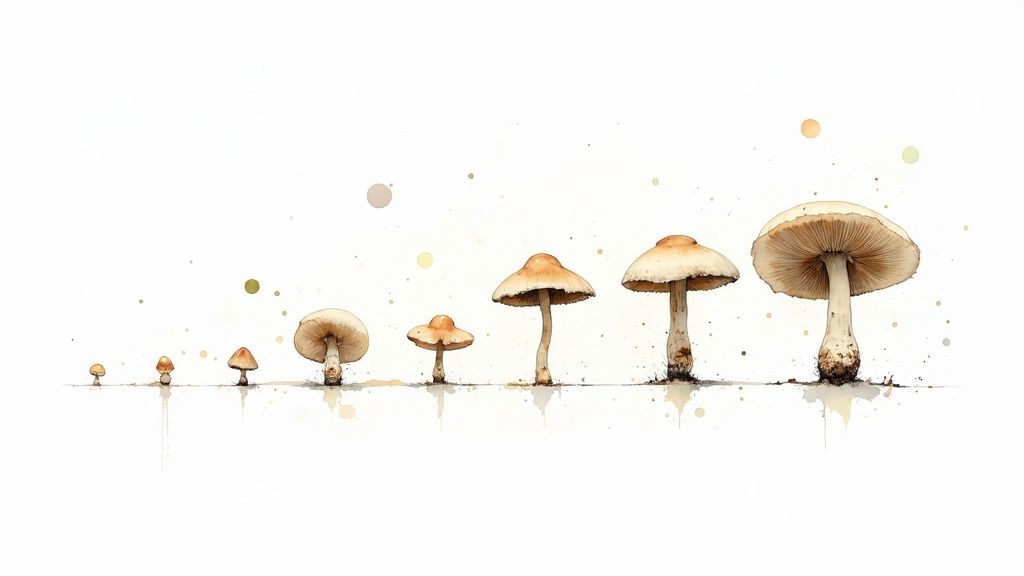
Identifying Problems and Reusing Your Kit
Knowing what a healthy grow looks like is just as crucial as spotting trouble. For new growers, the biggest headache is almost always contamination.
Keep a sharp eye out for any strange colors showing up in your substrate. If you see patches of green, black, or even orange, those are tell-tale signs of mold. Unfortunately, if you spot them, the kit is a loss and needs to be carefully discarded to keep mold spores from spreading.
Now for the exciting part: Can you get more than one harvest? Absolutely! Most kits are capable of producing multiple rounds of mushrooms, which are called “flushes.” After you’ve picked your first batch, keep up with the humidity and fresh air, and the mycelial block will often push out a second, third, or sometimes even a fourth flush. Just know that each one is usually a little smaller than the last.
If there’s one mistake beginners make, it’s getting impatient or breaking sterile protocol. The urge to constantly check on your kit is strong, but every time you open it up, you risk introducing contaminants. Trust the process, follow the directions, and let the fungi do their thing.
Final Tips for a Successful Grow
To wrap things up, here are a few final pieces of advice to help you steer clear of common pitfalls and head straight for a bountiful harvest.
- Follow Instructions Exactly: Don’t go off-script on your first try. The instructions are there for a reason and have been dialed in for success.
- Sterility is Everything: Always wash your hands well before you handle any part of your kit. A clean environment is your best defense against contamination.
- Be Patient: Mycology is a waiting game. Fight the urge to poke, prod, or mess with your kit. Give it the time and space it needs to do its magic.
Keeping these simple, practical tips in mind will set you up to navigate your first grow with total confidence.
Ready to start your own cultivation journey with a kit built for success? The Magic Mushroom Delivery offers a range of high-quality options perfect for beginners and seasoned growers alike. Explore our curated selection at https://themagicmushroomdelivery.com and take the first step today.




